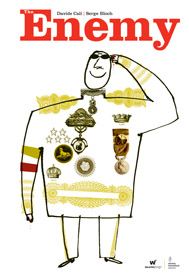A world of children’s books ignored
The following piece was part of a presentation I gave at the 2008 Children’s Book Council of Australia National Conference in Melbourne in May 2008. It was an attempt to explain why we publish some of the books we do. It was subsequently published in the August 2008 issue of Bookseller+Publisher magazine:
While most of the books released in Australia originate from overseas, they come predominantly from the UK and US. While there are some notable exceptions (such as the US publisher Kane Miller), most British and American children’s publishers aren’t hugely interested in publishing many books that stray from established Anglo-American tastes and which don’t reflect and reinforce Anglo-American perspectives.
That shouldn’t surprise us, and I’m not pretending to condemn it. After all, publishing something new or different is risky, and a publisher’s first duty is to make enough money to stay in business.
However, I travel each year to the world’s biggest book fair in Frankfurt, Germany and the resounding chorus I hear from European and Asian publishers is that ‘the British aren’t buying our books.’ This disappoints them not only because because they have good books to sell, but also because they buy a lot of British books. (In Germany, for example, there are perhaps ten English-language books being translated into German for every one book going the other way.)
It’s obvious that if the British don’t buy books from Europe or Asia (or South America or Africa), then they don’t get translated into English and, due to Britain’s long-established and rather arcane hold over the Australian book market, they don’t get released here in Australia. The Americans are actually a little more open-minded in their publishing, but less of their books make it to Australia due to territorial copyright restrictions.
Each year at Frankfurt I see wonderful children’s books, award-winning children’s books, big-selling children’s books, innovative, memorable and challenging children’s books. But Australian children are likely to read only a fraction of them merely because these books were originally published in a language other than English.
That’s a shame, because you learn two things when you read a book from a culture other than your own.
You learn that you share a planet with people who have different perspectives to you, do different things, wear different clothes, have different life experiences, face very different challenges, eat different food, sing different songs, tell different stores, and see their own very different landscape through very different eyes. And you get to walk a mile in their shoes.
You also learn that you have a whole lot in common with these people. Like you, they love their families, like you they get lonely, they laugh and cry, like you they fear the unknown, they have plans to make their lives better. You discover that you share a common humanity; that, in fact, you are a part of a humanity that stretches beyond your ken to parts of this wide world you’ll probably never visit.
I believe these are two important things for all children to learn, and they can learn them from books.
That’s why Wilkins Farago started publishing picture books from non-English-speaking cultures a few years back. I was actually encouraged to do so by a bookseller, Ron McCarthy of Australian Standing Orders, who saw the first book I found, from a Slovenian illustrator called Lila Prap, and gave me a handsome order that enabled me to fund its first printing. With the additional support of Australia’s independent booksellers, her book Why? has gone on to sell about 10,000 copies here and is still selling strongly, making Australia the second largest market in the world for this particular book after Germany.
The Hangilsa Stand at the 2005 Seoul Book Fair, where I first saw the artwork to 'Waiting for Mummy'.
Since then, we have published books from Korea, Italy and France. I found the Korean book Waiting for Mummy by chance at the 2005 Seoul Book Fair. I imagine the young woman at the Hangilsa Publishing stand is still bemused by the memory of a grown Western man clutching a children’s picture book asking if she’d be kind enough to read it to me in her broken English. Few western publishers make the trip to Korea, which has a huge and flourishing book market, much bigger than our own.
I didn’t realise Waiting for Mummy had won the Korean Children’s Book of the Year Award – the Baeksang Publishing Award – until after I’d bought the rights. This year, it’s finally been published in the US and also in Germany, where it is shortlisted for this year’s Deutscher Jugendliteraturpreis, Germany’s national children’s book awards.
Waiting for Mummy exemplifies what I have been talking about. A story set in another country and another time – Korea in the 1930s, when the country was under Japanese rule. Everything about the look is alien to the average Australian child, it even has snow in it. Yet it is a simple story to which any child can relate – of having to wait patiently for mum, and of eventually having that patience rewarded.
(For an adult reader, it contains more poignancies. We can learn from our history books that often Korean parents at this time did not come home to their children, but were forced by the Japanese into labour camps, or worse. For me, it was also all the more touching to know that the author Tae-Jun Lee, who died in the 1950s, was orphaned himself. His own mother and father never came home. Of course, a child sees none of this. They only enjoy the relief of a happy ending, the mother and child reunited, the tension resolved … and the red lollipop the little boy is holding in the last illustration.)
A big find has been the Swiss-Italian author Davide Cali, who was virtually unknown here in Australia before we published his picture book A Dad Who Measures Up last year.
Davide Cali's The Enemy was first published in English in Australia, and thereafter was picked by a US publisher.
Cali is huge in Europe. His books are available in 13 different languages and his reputation is as one of the most interesting, innovative, witty and emotionally attuned writers for young children. However, his work has been virtually ignored by English-language publishers until very recently. I’m pleased to see that’s changing. Since Wilkins Farago published the first English translation of his amazing anti-war book The Enemy, it has been picked up by Random House in the US. The next of his books, Piano Piano, will actually be published here after its publication in the US, and we have several more Davide Cali books in the pipeline, including a hilarious Christmas title.
I’m still waiting to hear news of a Davide Cali’s children’s book being picked up by a British publisher, however. (Probably just as well for us!)
Wilkins Farago isn’t the only publisher doing this kind of thing in this region. Some books do get through. For several years, Allen & Unwin has published translations of European young adult novels and New Zealand publisher Gecko Press is also developing its own picture book list along similar lines to our own. Fortunately, there is no shortage of quality foreign language books for all of us to consider. I am currently looking at new books from Spain, South America, Taiwan and Italy and I never know what I’m going to find next, nor where I’m going to find it.
Ultimately, I hope there will come a time when Australian authors and illustrators start appearing on our list. For even in Australian English, there are perspectives and cultures we don’t typically experience, and voices we don’t typically get to hear in our children’s books. It would be nice to publish some of them too.



